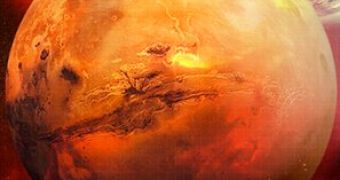Becoming a Martian while never leaving this planet might not have the same appeal or deliver the adrenaline levels that setting an actual foot on the soil of Mars would, but then again, exploring is not what it used to be. And don’t think for a minute that the comfort of an Earth home and exploring the alien, distant and cold surface of Mars can’t seamlessly go hand in hand. In fact, through a collaboration between Microsoft and NASA, users that would otherwise never get a chance to jump planets in the solar system, can visit Earth’s reddish neighbor using nothing more than their browser and the Silverlight plug-in as equipment.
The Redmond company and National Aeronautics and Space Administration are literally inviting users to become Martians and start exploring and mapping the Red Planet. Leveraging various examples of Microsoft technology, including Silverlight and the Windows Azure Cloud platform, NASA has launched “Be a Martian,” a new citizen-science Web site.
“We really need the next generation of explorers,” explained Michelle Viotti, director of Mars Public Outreach at NASA’s Jet Propulsion Laboratory. “And we’re also accomplishing something important for NASA. There’s so much data coming back from Mars. Having a wider crowd look at the data, classify it and help understand its meaning is very important.”
According to NASA, Mars orbiters have captured and sent back to Earth in excess of half a million images of the planet. One example of how “Be a Martian” will involve the community is a game inviting users to map Mars. While almost all the existing content was indeed mapped, there are images that have so far been left out, as well as new materials from Mars orbiters coming in constantly.
“It’s a fun, casual game with beautiful images that also has a real purpose,” noted the director of business innovation for DPE, Marc Mercuri. “You don’t need a degree in science, but you can contribute back to the space program right away. And for those who are inspired, particularly the next generation, it opens up a path for continued learning that we hope may actually lead to advanced degrees later on.”
Essentially, when a project of this magnitude taps general users for their input, the terms which describes the collaboration is crowd-sourcing. It takes an immense level of disparate contributions in order to finalize a project as huge as mapping Mars correctly. But the exploration of Mars doesn’t stop at mapping.
A second game provided by the website involves having users help with the geological study of the Red Planed. By doing nothing more than simply counting craters on the Mars surface, users can contribute to determining whether the Red Planet’s environment is capable of sustaining microbes, for example.
“Running applications based on the Windows Azure platform through cloud services provides the ability to scale to any level,” Mercuri added. “The system dedicates an appropriate amount of processors to the application, whether it’s being used by 250, 250,000 or 2,500,000 people at the same time.”

 14 DAY TRIAL //
14 DAY TRIAL //